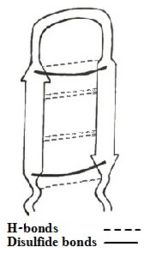Tachyplesin
From Proteopedia
(Difference between revisions)
(Undo revision 2348791 by Michal Harel (Talk)) |
|||
| Line 1: | Line 1: | ||
== Introduction == | == Introduction == | ||
<StructureSection load='1MA2' size='340' side='right' caption='[[1ma2]]' scene='67/671725/First_scene/2'> | <StructureSection load='1MA2' size='340' side='right' caption='[[1ma2]]' scene='67/671725/First_scene/2'> | ||
| - | + | Tachyplesin I (TP-I) is an [http://en.wikipedia.org/wiki/Antimicrobial_peptides antimicrobial polypeptide] originally detected in the leukocytes of Japanese [http://en.wikipedia.org/wiki/Horseshoe_crab Horse Shoe Crab]. It has also been reported to inhibit the growth of [http://en.wikipedia.org/wiki/Gram-positive_bacteria gram positive bacteria], [http://en.wikipedia.org/wiki/Fungus fungui] and [http://en.wikipedia.org/wiki/Virus viruses] suggesting its antimicrobial property. | |
The antimicrobial activity of the peptide is related to the composition of the pathogen membrane and ability of the peptide to permeabilize the cell membranes. Bacteria and fungi have negatively charged membranes, and the interaction of <scene name='67/671725/Cationic_peptide_tpi/1'> TP-I </scene> is mediated in large part by electrostatic interactions<ref name=Laederach>PMID:12369825</ref> (see the {{Template:ColorKey_Hydrophobic}} and {{Template:ColorKey_Polar}} amino acids). | The antimicrobial activity of the peptide is related to the composition of the pathogen membrane and ability of the peptide to permeabilize the cell membranes. Bacteria and fungi have negatively charged membranes, and the interaction of <scene name='67/671725/Cationic_peptide_tpi/1'> TP-I </scene> is mediated in large part by electrostatic interactions<ref name=Laederach>PMID:12369825</ref> (see the {{Template:ColorKey_Hydrophobic}} and {{Template:ColorKey_Polar}} amino acids). | ||
Specifically, TP-I shows high affinity for [http://en.wikipedia.org/wiki/Lipopolysaccharide lipopolysaccharides (LPS)] of [http://en.wikipedia.org/wiki/Gram-negative_bacteria gram-negative bacteria], thus neutralizing its effects. | Specifically, TP-I shows high affinity for [http://en.wikipedia.org/wiki/Lipopolysaccharide lipopolysaccharides (LPS)] of [http://en.wikipedia.org/wiki/Gram-negative_bacteria gram-negative bacteria], thus neutralizing its effects. | ||
| Line 75: | Line 75: | ||
It was found that the synthetic tachyplesin conjugated to the integrin homing domain (RGD-tachyplesin) can inhibit the [http://en.wikipedia.org/wiki/Cell_growth proliferation] of TSU tumor cells [http://en.wikipedia.org/wiki/Prostate_cancer prostate cancer] and B16 [http://en.wikipedia.org/wiki/Melanoma melanoma] cells as well as [http://en.wikipedia.org/wiki/Endothelium endothelial cells] in a dose-dependent mannar <i>in vitro</i> and reduce tumor growth <i>in vivo</i> by inducing [http://en.wikipedia.org/wiki/Apoptosis apoptosis].<ref name=Chen>PMID:11289111</ref>. Besides this RGD-tachyplesin can activate caspases and induce Fas ligand, which are the markers for programmed cell death (PCD). Collectively, suppression of tumor associated cell and induction of programmed cell death will eventually act as therapy for cancer and tumor cells. | It was found that the synthetic tachyplesin conjugated to the integrin homing domain (RGD-tachyplesin) can inhibit the [http://en.wikipedia.org/wiki/Cell_growth proliferation] of TSU tumor cells [http://en.wikipedia.org/wiki/Prostate_cancer prostate cancer] and B16 [http://en.wikipedia.org/wiki/Melanoma melanoma] cells as well as [http://en.wikipedia.org/wiki/Endothelium endothelial cells] in a dose-dependent mannar <i>in vitro</i> and reduce tumor growth <i>in vivo</i> by inducing [http://en.wikipedia.org/wiki/Apoptosis apoptosis].<ref name=Chen>PMID:11289111</ref>. Besides this RGD-tachyplesin can activate caspases and induce Fas ligand, which are the markers for programmed cell death (PCD). Collectively, suppression of tumor associated cell and induction of programmed cell death will eventually act as therapy for cancer and tumor cells. | ||
| - | |||
| - | == 3D Structures of tachyplesin I== | ||
| - | |||
| - | Updated on {{REVISIONDAY2}}-{{MONTHNAME|{{REVISIONMONTH}}}}-{{REVISIONYEAR}} | ||
| - | |||
| - | [[1ma2]], [[1ma5]], [[1wo0]], [[1wo1]], [[2mdb]], [[2rtv]] – TacI peptide residues 24-40 – Japanese horseshoe crab - NMR<br /> | ||
| - | [[1ma4]], [[1ma6]] – TacI peptide residues 24-40 (mutant) - NMR<br /> | ||
| - | [[2lm8]] – TacI peptide residues 1-13 (mutant) - NMR<br /> | ||
</StructureSection> | </StructureSection> | ||
Revision as of 11:49, 19 January 2015
Introduction
| |||||||||||
References
- ↑ 1.0 1.1 1.2 Laederach A, Andreotti AH, Fulton DB. Solution and micelle-bound structures of tachyplesin I and its active aromatic linear derivatives. Biochemistry. 2002 Oct 15;41(41):12359-68. PMID:12369825
- ↑ 2.0 2.1 Chen, Yixin, et al. "RGD-Tachyplesin inhibits tumor growth." Cancer research 61.6 (2001): 2434-2438.
- ↑ Nakamura, Takanori, et al. "Tachyplesin, a class of antimicrobial peptide from the hemocytes of the horseshoe crab (Tachypleus tridentatus). Isolation and chemical structure." Journal of Biological Chemistry 263.32 (1988): 16709-16713
- ↑ Kushibiki T, Kamiya M, Aizawa T, Kumaki Y, Kikukawa T, Mizuguchi M, Demura M, Kawabata SI, Kawano K. Interaction between tachyplesin I, an antimicrobial peptide derived from horseshoe crab, and lipopolysaccharide. Biochim Biophys Acta. 2014 Jan 2;1844(3):527-534. doi:, 10.1016/j.bbapap.2013.12.017. PMID:24389234 doi:http://dx.doi.org/10.1016/j.bbapap.2013.12.017
- ↑ 5.0 5.1 Saravanan R, Mohanram H, Joshi M, Domadia PN, Torres J, Ruedl C, Bhattacharjya S. Structure, activity and interactions of the cysteine deleted analog of tachyplesin-1 with lipopolysaccharide micelle: Mechanistic insights into outer-membrane permeabilization and endotoxin neutralization. Biochim Biophys Acta. 2012 Mar 23;1818(7):1613-1624. PMID:22464970 doi:10.1016/j.bbamem.2012.03.015
- ↑ 6.0 6.1 6.2 Hong, Jun, et al. "Mechanism of tachyplesin I injury to bacterial membranes and intracellular enzymes, determined by laser confocal scanning microscopy and flow cytometry." Microbiological research (2014).
- ↑ Yonezawa A, Kuwahara J, Fujii N, Sugiura Y. Binding of tachyplesin I to DNA revealed by footprinting analysis: significant contribution of secondary structure to DNA binding and implication for biological action. Biochemistry. 1992 Mar 24;31(11):2998-3004. PMID:1372516
- ↑ Lipsky A, Cohen A, Ion A, Yedidia I. Genetic transformation of Ornithogalum via particle bombardment and generation of Pectobacterium carotovorum-resistant plants. Plant Sci. 2014 Nov;228:150-8. doi: 10.1016/j.plantsci.2014.02.002. Epub 2014 Feb, 12. PMID:25438795 doi:http://dx.doi.org/10.1016/j.plantsci.2014.02.002
Quiz
Proteopedia Page Contributors and Editors (what is this?)
Shulamit Idzikowski, Janak Raj Joshi, Michal Harel, Alexander Berchansky, Joel L. Sussman, Angel Herraez, Jaime Prilusky

